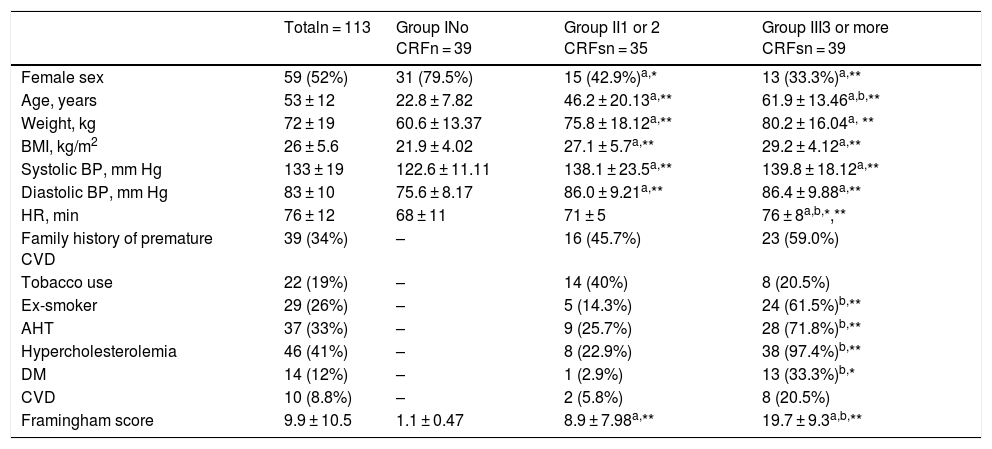The brachial-ankle pulse wave velocity (baPWV) is one of the most widely used arterial stiffness variables for assessing vascular risk. The abiPWV is a device that calculates various PWVs and the blood pressure ankle-brachial index (ABI). The device can also determine baPWV. The aim of this study was to calculate the baPWV with abiPWV, validate it with a reference device (VaSera) and study its clinical usefulness.
Patients and methodsWe studied 113 patients (mean age, 53 ± 12 years), 59 (52%) of whom were women, and 10 (8.8%) of whom had a previous cardiovascular event. The participants were classified according to cardiovascular risk factors (CRFs) into group I (none), group II (1 or 2 CRFs) and group III (3 or more CRFs). The patients with a previous cardiovascular event were included in group III. All participants had their baPWV measured with abiPWV and VaSera.
ResultsThe baPWV correlation between the 2 devices was r = 0.93 (p < .001), and the percentage error calculated with the Bland-Altman analysis was 4.5%. The baPWV measured with abiPWV (in m/s) was as follows: group I, 10.5 ± 1.6; group II, 13.8 ± 2.9 (p < .001 when compared with group I); and group III, 14.1 ± 2.7 (p < .001 when compared with group I). There were no differences between groups II and III. The results with VaSera were comparable to those of abiPWV.
ConclusionsMeasuring baPWV with the abiPWV is safe and has a similar clinical utility to that of VaSera. Incorporating this function into the options of abiPWV makes it a complete device for assessing arterial stiffness.
La velocidad de Onda de Pulso brazo-tobillo (VOPbt) es una de las variables de rigidez arterial más empleada en la valoración del riesgo vascular. VOPITB es un dispositivo que calcula distintas VOP y el Indice Tobillo Brazo de presión arterial (ITB). Además, con sus registros se podría determinar la VOPbt. El objetivo de este estudio fue: calcular la VOPbt con VOPITB, validarlo con un equipo de referencia (VaSera) y estudiar su utilidad clínica.
Pacientes y métodosSe estudiaron 113 pacientes, con edad media 53 ± 12 años; 59 (52%) eran mujeres y 10 (8,8%) presentaban evento cardiovascular previo. Los participantes se estatificaron según factores de riesgo vascular (FRV) en: grupo I, ninguno; grupo II, 1 o 2, y grupo III, 3 o más FRV. Los pacientes con algún evento vascular previo se incluyeron en el grupo III. A todos se les midió la VOPbt con VOPITB y VaSera.
ResultadosLa correlación de VOPbt entre ambos equipos fue r =0,93 (p < 0,001) y el porcentaje de error calculado con análisis de Bland-Altman: 4.5%. La VOPbt con VOPITB fue (m/s): grupo I,10,5 ± 1,6 comparado con grupo II, 13,8 ± 2,9 (p < 0,001), y grupo III, 14,1 ± 2,7 (p < 0,001). No se observaron diferencias entre los grupos II y III. Los resultados obtenidos con VaSera fueron equiparables a los de VOPITB.
ConclusionesLa medición de la VOPbt con el equipo VOPITB es segura y de utilidad clínica similar a la realizada con VaSera. La incorporación de esta función a las prestaciones de VOPITB lo convertirá en un dispositivo completo para valorar la rigidez arterial.
Article
Diríjase desde aquí a la web de la >>>FESEMI<<< e inicie sesión mediante el formulario que se encuentra en la barra superior, pulsando sobre el candado.

Una vez autentificado, en la misma web de FESEMI, en el menú superior, elija la opción deseada.

>>>FESEMI<<<









